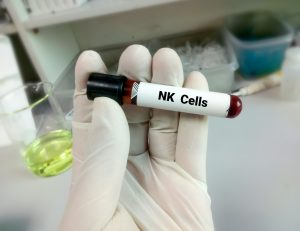Scientists say they have identified immune cell types that could be targeted to develop specific immunotherapies in chemotherapy-resistant breast cancers. A research team from King’s College London and The Institute of Cancer Research, London, with support from Breast Cancer Now, explained that they performed a deep dive into the different immune markers within tumor tissues and blood samples of early breast cancer patients whose cancer failed to respond to chemotherapy given to them prior to surgery.
Their study “Dynamic Changes in the NK-, Neutrophil-, and B-cell Immunophenotypes Relevant in High Metastatic Risk Post Neoadjuvant Chemotherapy–Resistant Early Breast Cancers,” which appears in Clinical Cancer Research, gives insight into the function of immune cells in patients with chemotherapy-resistant breast cancers, note the researchers. While chemotherapy may not kill cancer cells in these high-risk patients, immunotherapy, a type of treatment that helps the immune system to attack cancer cells, may provide a benefit.
“To identify potential immune targets in post-neoadjuvant chemotherapy (NAC)–resistant triple-negative breast cancer (TNBC) and ER+HER2– breast cancer disease,” write the investigators.
“Following pathology review, 153 patients were identified as having residual cancer burden (RCB) II/III disease (TNBC n = 80; ER+HER2–n = 73). Baseline pre-NAC samples were available for evaluation for 32 of 80 TNBC and 36 of 73 ER+HER2– cases. Bright-field hematoxylin and eosin assessment allowed for tumor-infiltrating lymphocyte (TIL) evaluation in all cases. Multiplexed immunofluorescence was used to identify the abundance and distribution of immune cell subsets. Levels of checkpoints including PD-1/PD-L1 expression were also quantified. Findings were then validated using expression profiling of cancer and immune-related genes. Cytometry by time-of-flight characterized the dynamic changes in circulating immune cells with NAC.”
“RCB II/III TNBC and ER+HER2– breast cancer were immunologically ‘cold’ at baseline and end of NAC. Although the distribution of immune cell subsets across subtypes was similar, the mRNA expression profiles were both subtype- and chemotherapy-specific. TNBC RCB II/III disease was enriched with genes related to neutrophil degranulation and displayed strong interplay across immune and cancer pathways.
“We observed similarities in the dynamic changes in B-cell biology following NAC irrespective of subtype. However, NAC induced changes in the local and circulating tumor immune microenvironment (TIME) that varied by subtype and response. Specifically, in TNBC residual disease, we observed downregulation of stimulatory (CD40/OX40L) and inhibitory (PD-L1/PD-1) receptor expression and an increase in NK cell populations (especially non-cytolytic, exhausted CD56dimCD16–) within both the local TIME and peripheral white cell populations.
“This study identifies several potential immunologic pathways in residual disease, which may be targeted to benefit high-risk patients.”
To investigate the immune environment that surrounds these chemotherapy resistant tumors, scientists employed multiple and novel complementary technologies looking at proteins and genes on both pre-treatment and post-treatment breast cancer tissue. They also measured how 1,330 cancer and immune-related genes within cancer tissues were affected by chemotherapy.

They found that chemotherapy resistant cancer cells had few immune cells around them, but chemotherapy did induce changes in several immune cell types. Specifically, they found increases in the number of “innate” (first responder) cells such as neutrophils and natural killer (NK) cells. NK cells help the body to fight infection and cancer. But analysis found the increased NK cells in patients with chemotherapy resistant disease lacked cytotoxic activity – the “killing instinct.”
Researchers also found immune-related genes associated with NK cells were those associated with cell inhibition or exhaustion, which meant NK cells were unable to fight cancer cells. This new insight into the behavior of NK cells could be used to develop specific immunotherapies for these high-risk patients. This would need to be investigated in future clinical trials.
These findings also show that blood monitoring during chemotherapy may help predict chemotherapy response early, potentially allow for tailoring of treatment prior to surgery.
“Chemotherapy resistance in aggressive early breast cancers is a major reason why cancer regrows after treatment, contributing significantly to people not surviving their disease,” says Sheeba Irshad, PhD, Cancer Research UK Clinician Scientist, Kings College London. “In order to find the right targets for drug developments, it’s important to have a deep understanding of the complex mechanisms that allow some cancer cells to resist treatment, then hide from our immune system to only re-emerge later when they’re harder to eradicate.
“Our work has identified several cell types that would be worth investigating further to understand how they are interacting with the resistant cancer cell and how we can tweak that for our benefit. I am excited to continue to investigate these findings further.”






